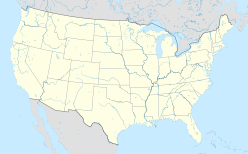Cloud Creek crater facts for kids
| Impact crater/structure | |
|---|---|
| Confidence | Confirmed |
| Diameter | 7 km (4.3 mi) |
| Age | 190 ± 30 Ma Early or Middle Jurassic or Late Triassic |
| Exposed | No |
| Drilled | Yes |
| Location | |
| Location | Casper Arch |
| Coordinates | 43°7′N 106°45′W / 43.117°N 106.750°W |
| Country | |
| State | Wyoming |
| Province | Natrona County |
The Cloud Creek crater is a giant hole in the ground made by a space rock hitting Earth. It is an impact crater located in Wyoming, United States. You can find it in Natrona County, about 48 miles (77 km) northwest of Casper. It sits near the middle of a geological area called the Casper Arch.
This crater is shaped like a circle and is about 7 kilometers (4.3 miles) wide. It is buried deep underground, hidden beneath about 1,200 meters (3,900 feet) of younger rocks. Scientists believe the crater formed around 190 million years ago. This means it was created during the early part of the Jurassic Period, a time when dinosaurs roamed the Earth!
You cannot see the Cloud Creek crater from the surface. We know it exists because of special wells drilled to find oil and gas. Scientists also used special tools like seismic waves, gravity, and magnetic readings to map it out.
How Scientists Found It
The Cloud Creek crater has a central part made of broken and cracked rocks. These rocks were pushed up about 520 meters (1,700 feet) higher than the normal rock layers around them. This central area is surrounded by a ring-shaped valley. Around this valley is a raised ring of rock, which marks the 7-kilometer (4.3-mile) edge of the crater.
Later, during a time called the Laramide compression, the Earth's crust was squeezed. This squeezing pushed up and changed the crater's structure even more. The way the crater is shaped and its measurements match other known impact craters around the world.
Scientists used different methods to study the crater:
- Seismic lines: These are like underground X-rays that show how rock layers are arranged.
- Gravity data: This helps find areas where rocks are denser or less dense, which can show buried structures.
- Magnetic data: This can detect changes in magnetic rocks underground.
- Borehole data: Information from the wells drilled into the ground.
History of Discovery
The first official report about the Cloud Creek Structure was published in 1985. However, a geologist named Jack Wroble from Casper likely suggested it was an impact crater sometime after 1973.
Many wells have been drilled in the Cloud Creek area to search for oil and gas. Between 1955 and 1999, ten wells were drilled within the crater's boundaries. Two of these wells went into the central peak of the crater. Four wells were drilled in the area surrounding the center, and four others went through the outer rim. These drillings helped scientists understand the hidden structure of the crater.



